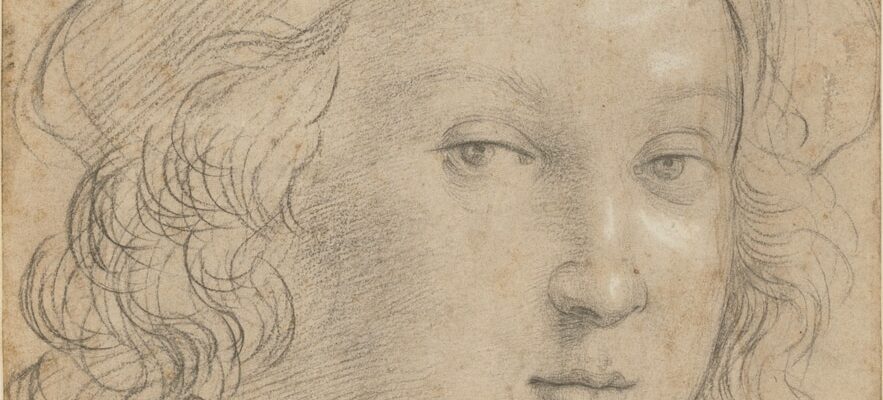Thanks to the bequest of the “knight” Jean-Baptiste Wicar to his hometown of Lille, the Palace of Fine Arts preserves nearly 40 sheets attributed to Raphaël. Due to their fragility, the precious drawings had until now been very rarely shown to the public and never together. This shows the event that today constitutes their meeting on the picture rails, enhanced by subtle lighting to protect them from too strong light. From Perugia to Rome, via Florence, this exceptional corpus covers around fifteen years of creation by the late artist, at the height of his glory, at the age of 37, and constitutes, for a large part, the primary matrix of his masterpieces. Some emblematic paintings by the master also punctuate the graphic journey, such as the Portrait of the artist with a friendon loan from the Louvre, or the iconic Virgin and Child with the Baptist Childkept at the National Gallery in London.
From the period in Perugia, when the young painter born in Urbino worked in Perugino’s workshop and was quick to respond to prestigious commissions, several preparatory studies remain, such as those for the Pala degli Oddi Or The Virgin and Child Holding a Book. Other sketches still keep their secrets, like the Head of a young man with a barrette (referring to the headdress worn by men during the Renaissance). Is this a self-portrait or a preparation for one of the angels of the Pala degli Oddi whose features would have been idealized on the painted version? “This drawing can be compared to theSelf-portrait by Raphael made around 1506 and kept in the Uffizi, where the artist represents himself in three-quarter view, wearing a cap, on a neutral background”, says Cordélia Hattori, the curator of the exhibition alongside Juliette Singer and Régis Cotentin And the curator adds that “the realism of the face denotes an influence from the northern schools, which the painter Giovanni Santi, father of Raphaël, prized.”
Raphaël, “Head of a young man wearing a barrette” (black stone and white gouache).
/ © Grand Palais – RMN (PBA, Lille): Adrien Didierjean
The icing on the cake is that five of the sheets shown in Lille, covered on the front and back, or ten drawings in total, were scrutinized by the Center for Research and Restoration of Museums of France, the famous C2RMF. The magical combination of scientific imaging and spectroscopy not only made it possible to reveal and map a network of colorless lines forming slight incisions in the paper, but also to precisely identify the materials used. Thus, thanks to X-rays, we now know that Raphaël had drawn the features of one of the figures in the study for the Pala Baronci using a lead point, and not an achrome stylus as a simple visual examination led us to believe until then, and that the painter then erased these lines with breadcrumbs before starting again the outline in black stone.
Here, technology dialogues harmoniously with the past. Its title implies, Raphael Experience is intended to be an “augmented” exhibition, with digital devices showing how the virtuoso artist, and sometimes deliciously fanciful in his doodles, goes from drawing to painted work. The visitor will even be able to virtually enter the room of the Signature at the Vatican to discover the creation of its famous frescoes. Or watch in the atrium a film projected at 360° which retraces the fantasy life of a young prodigy “touched by grace”, in the words of Vasari, the tireless echoer of the geniuses of the Italian Renaissance brush.
